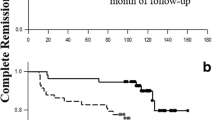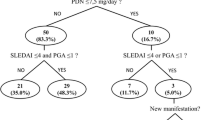Abstract
Prolonged remission (PR), defined as a 5-year consecutive period of no disease activity based on SLEDAI-2K, has been reported to be associated with a lower damage accrual over time in patients with systemic lupus erythematosus (SLE), as the consequence of a lower activity burden. Since disease activity is considered to play a role in the incidence of cardiovascular disease (CVD), we investigated the relationship, if any, between PR and the occurrence of a subsequent first CV event in patients with SLE. Out of 488 patients consecutively admitted to two tertiary Italian centers from November 1, 2000, to December 31, 2016, the 294 patients, who had been followed at least for 5 years, had not experienced any CV event at admission, and had been visited biannually during follow-up, were considered for the present study. The incidence of a first CV in patients who had achieved PR was compared with that registered in those who had not. Moreover, it was compared among PR patients subdivided into three groups: complete remission, clinical off-corticosteroids (offCR), and clinical on-corticosteroids remission (onCR). Kaplan–Meier curves and the log-rank test were used to analyze differences in event-free survival among groups. Cox regression was used to investigate disease and therapeutic features associated with the development of a first CV event. During 9 years median follow-up time, 24 (8.1%) CV events occurred. Out of the 294 patients, 126 (42.8%) had achieved PR. Kaplan–Meier analysis revealed a greater overall CV event-free rate in these patients as compared to both those with a shorter lasting remission and those who had never remitted (log-rank test χ2 = 14.43; p = 0.0001). In addition, CV outcome did not differ among PR patients, irrespectively the type of remission achieved (p > 0.05). At multivariate analysis, hydroxychloroquine therapy and PR resulted to be protective (HR 0.19; HR 0.18), while arterial hypertension and antiphospholipid positivity increased the risk of a first CV event (HR 2.61; HR 2.47). The PR, whichever the subtype, is associated with a better CV outcome and should be considered as a treat-to-target goal in the CV risk management of the lupus patient.


Similar content being viewed by others
References
Bartels CM, Buhr KA, Goldberg JW, Bell CL, Visekruna M, Nekkanti S, Greenlee RT (2014) Mortality and cardiovascular burden of systemic lupus erythematosus in a US population-based cohort. J Rheumatol 41(4):680–687
McMahon M, Hahn BH, Skaggs BJ (2011) Systemic lupus erythematosus and cardiovascular disease: prediction and potential for therapeutic intervention. Expert Rev Clin Immunol 7(2):227–241
Zeller CB, Appenzeller S (2008) Cardiovascular disease in systemic lupus erythematosus: the role of traditional and lupus related risk factors. Curr Cardiol Rev 4(2):116–122
Magder LS, Petri M (2012) Incidence of and risk factors for adverse cardiovascular events among patients with systemic lupus erythematosus. Am J Epidemiol 176(8):708–719
Iudici M, Fasano S, Gabriele Falcone L, Pantano I, La Montagna G, Migliaresi S et al (2016) Low-dose aspirin as primary prophylaxis for cardiovascular events in systemic lupus erythematosus: a long-term retrospective cohort study. Rheumatology (Oxford) 55(9):1623–1630
Fasano S, Pierro L, Pantano I, Iudici M, Valentini G (2017) Longterm hydroxychloroquine therapy and low-dose aspirin may have an additive effectiveness in the primary prevention of cardiovascular events in patients with systemic lupus erythematosus. J Rheumatol 44(7):1032–1038
Fasano S, Margiotta DP, Navarini L, Pierro L, Pantano I, Riccardi A, Afeltra A, Valentini G (2017) Primary prevention of cardiovascular disease in patients with systemic lupus erythematosus: case series and literature review. Lupus 26(14):1463–1472
Barr SG, Zonana-Nacach A, Magder LS, Petri M (1999) Patterns of disease activity in systemic lupus erythematosus. Arthritis Rheum 42(12):2682–2688
Zen M, Iaccarino L, Gatto M, Bettio S, Nalotto L, Ghirardello A, Punzi L, Doria A (2015) Prolonged remission in Caucasian patients with SLE: prevalence and outcomes. Ann Rheum Dis 74(12):2117–2122
Multi-Ethnic Study of Atherosclerosis. MESA Study Events Manual of Operations. Bethesda: National Heart, Lung, and Blood Institute, 2004
Gladman DD, Ibañez D, Urowitz MB (2002) Systemic lupus erythematosus disease activity index 2000. J Rheumatol 29(2):288–291
Ghirardello A, Villalta D, Morozzi G, Afeltra A, Galeazzi M, Gerli R et al (2011) Diagnostic accuracy of currently available anti-double-stranded DNA antibody assays. An Italian multicentre study. Clin Exp Rheumatol 29(1):50–56
Gladman D, Ginzler E, Goldsmith C, Fortin P, Liang M, Urowitz M et al (1996) The development and initial validation of the systemic lupus international collaborating clinics/American College of Rheumatology damage index for systemic lupus erythematosus. Arthritis Rheum 39(3):363–369
Brandt JT, Triplett DA, Alving B, Scharrer I (1995) Criteria for the diagnosis of lupus anticoagulants: an update. On behalf of the subcommittee on lupus anticoagulant/Antiphospholipid antibody of the scientific and standardisation committee of the ISTH. Thromb Haemost 74(4):1185–1190
Gordon C, Amissah-Arthur M-B, Gayed M, Brown S, Bruce IN, D’Cruz D, Empson B, Griffiths B, Jayne D, Khamashta M, Lightstone L, Norton P, Norton Y, Schreiber K, Isenberg D, for the British Society for Rheumatology Standards, Audit and Guidelines Working Group (2018) The British Society for Rheumatology guideline for the management of systemic lupus erythematosus in adults. Rheumatology (Oxford) 57(1):e1–e45
Buyon JP, Petri MA, Kim MY, Kalunian KC, Grossman J, Hahn BH, Merrill JT, Sammaritano L, Lockshin M, Alarcón GS, Manzi S, Belmont HM, Askanase AD, Sigler L, Dooley MA, von Feldt J, McCune WJ, Friedman A, Wachs J, Cronin M, Hearth-Holmes M, Tan M, Licciardi F (2005) The effect of combined estrogen and progesterone hormone replacement therapy on disease activity in systemic lupus erythematosus: a randomized trial. Ann Intern Med 142(12 Pt 1):953–962
Doria A, Shoenfeld Y, Wu R, Gambari PF, Puato M, Ghirardello A et al (2003) Risk factors for subclinical atherosclerosis in a prospective cohort of patients with systemic lupus erythematosus. Ann Rheum Dis 62(11):1071–1077
Franklyn K, Lau CS, Navarra SV, Louthrenoo W, Lateef A, Hamijoyo L, Wahono CS, Chen SL, Jin O, Morton S, Hoi A, Huq M, Nikpour M, Morand EF (2016) Definition and initial validation of a lupus low disease activity state (LLDAS). Ann Rheum Dis 75(9):1615–1621
Polachek A, Gladman DD, Su J, Urowitz MB (2017) Defining low disease activity in systemic lupus erythematosus. Arthritis Care Res (Hoboken) 69(7):997–1003
van Vollenhoven R, Voskuyl A, Bertsias G, Aranow C, Aringer M, Arnaud L, Askanase A, Balážová P, Bonfa E, Bootsma H, Boumpas D, Bruce I, Cervera R, Clarke A, Coney C, Costedoat-Chalumeau N, Czirják L, Derksen R, Doria A, Dörner T, Fischer-Betz R, Fritsch-Stork R, Gordon C, Graninger W, Györi N, Houssiau F, Isenberg D, Jacobsen S, Jayne D, Kuhn A, le Guern V, Lerstrøm K, Levy R, Machado-Ribeiro F, Mariette X, Missaykeh J, Morand E, Mosca M, Inanc M, Navarra S, Neumann I, Olesinska M, Petri M, Rahman A, Rekvig OP, Rovensky J, Shoenfeld Y, Smolen J, Tincani A, Urowitz M, van Leeuw B, Vasconcelos C, Voss A, Werth VP, Zakharova H, Zoma A, Schneider M, Ward M (2017) A framework for remission in SLE: consensus findings from a large international task force on definitions of remission in SLE (DORIS). Ann Rheum Dis 76(3):554–561
Tsang-A-Sjoe MWP, Bultink IEM, Heslinga M, Voskuyl AE (2017) Both prolonged remission and Lupus Low Disease Activity State are associated with reduced damage accrual in systemic lupus erythematosus. Rheumatology (Oxford) 56(1):121–128
Wilhelm TR, Magder LS, Petri M (2017) Remission in systemic lupus erythematosus: durable remission is rare. Ann Rheum Dis 76(3):547–553
Gordon C (2002) Long-term complications of systemic lupus erythematosus. Rheumatology 41(10):1095–1100
Drenkard C, Villa AR, Garcia-Padilla C, Pérez-Vázquez ME, Alarcón-Segovia D (1996) Remission of systematic lupus erythematosus. Medicine (Baltimore) 75(2):88–98
Zen M, Iaccarino L, Gatto M, Bettio S, Saccon F, Ghirardello A, Punzi L, Doria A (2017) The effect of different durations of remission on damage accrual: results from a prospective monocentric cohort of Caucasian patients. Ann Rheum Dis 76(3):562–565
Gryglewski RD, Korbut R, Dembińska-Kieć A. Influence of Anti-Inflammatory Steroids on Prostaglandin and Thromboxane Release from Tissues. In: Prostaglandins and Thromboxanes [Internet]. Springer, Boston, MA; 1977 [cited 2018 May 3]. pp 363–81. (NATO Advanced Study Institutes Series). https://doi.org/10.1007/978-1-4684-2778-3_25
Fernández-Nebro A, Rúa-Figueroa Í, López-Longo FJ, Galindo-Izquierdo M, Calvo-Alén J, Olivé-Marqués A, Ordóñez-Cañizares C, Martín-Martínez MA, Blanco R, Melero-González R, Ibáñez-Rúan J, Bernal-Vidal JA, Tomero-Muriel E, Uriarte-Isacelaya E, Horcada-Rubio L, Freire-González M, Narváez J, Boteanu AL, Santos-Soler G, Andreu JL, Pego-Reigosa JM (2015) Cardiovascular events in systemic lupus erythematosus: a Nationwide study in Spain from the RELESSER registry. Medicine (Baltimore) 94(29):e1183
Fasano S, Margiotta DP, Gualtierotti R, Corrado A, Berardicurti O, Iacono D et al (2018) The incidence of cardiovascular events in Italian patients with systemic lupus erythematosus is lower than in North European and American cohorts: implication of disease-associated and traditional risk factors as emerged by a 16-year retrospective GIRRCS study: GIRRCS=Gruppo Italiano di Ricerca in Reumatologia Clinica e Sperimentale. Medicine (Baltimore) 97(15):e0370
Author information
Authors and Affiliations
Corresponding author
Ethics declarations
Disclosures
None.
Rights and permissions
About this article
Cite this article
Fasano, S., Margiotta, D.P.E., Pierro, L. et al. Prolonged remission is associated with a reduced risk of cardiovascular disease in patients with systemic lupus erythematosus: a GIRRCS (Gruppo Italiano di Ricerca in Reumatologia Clinica e Sperimentale) study. Clin Rheumatol 38, 457–463 (2019). https://doi.org/10.1007/s10067-018-4286-9
Received:
Revised:
Accepted:
Published:
Issue Date:
DOI: https://doi.org/10.1007/s10067-018-4286-9




